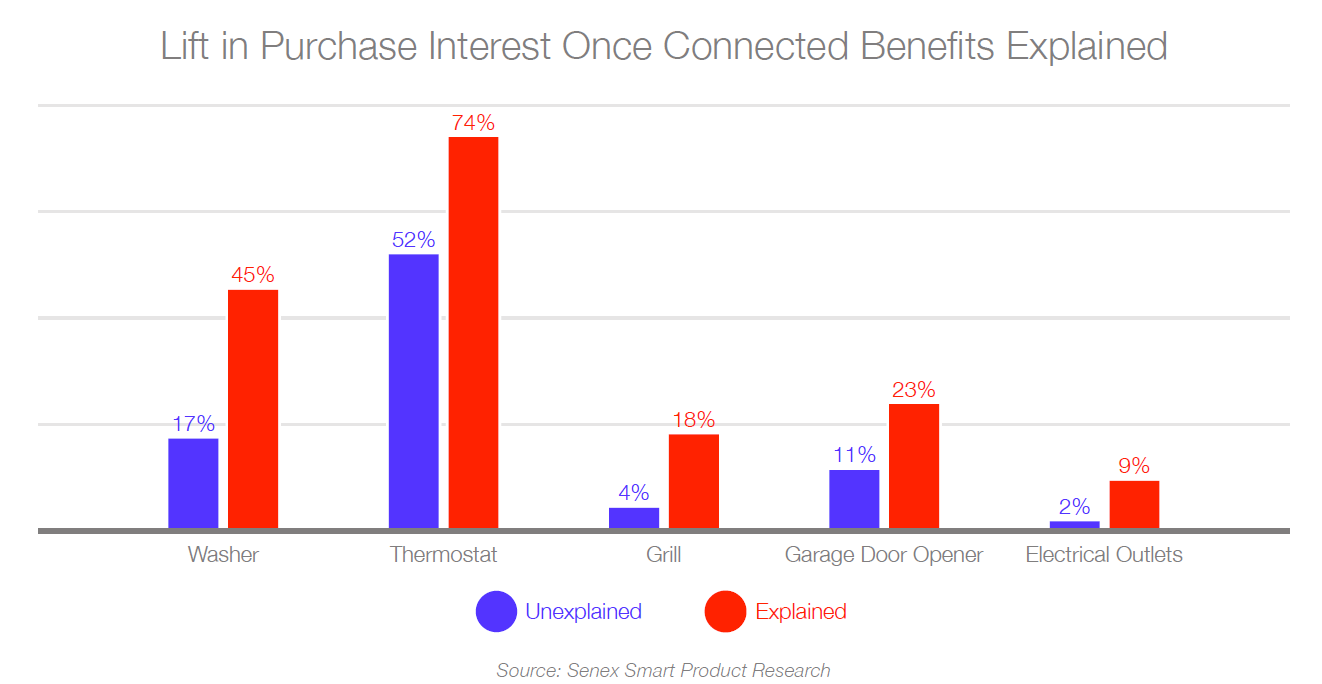Product Testing
Why aren't consumers buying smart home products?

To generate interest in true “smart homes” manufacturers must deliver more than merely “connected” products
Market Overview
Our research has consistently shown that while consumers do purchase what the industry calls "smart" product solutions, the products being purchased are in reality conventional home products hat have internet-connected features. These connected — but not interconnected — products DO NOT add up to what might be considered a "smart home" solution.
Relatively few products, notably some newer thermostats, can be said to be "smart" — chiefly because they learn from interactions, modifying heating and cooling settings based on patterns of use. Most newer appliances, smoke detectors, door locks, window shades, light bulbs, and garage door openers fall under the category of "connected". All access the internet, and require consumers to use a dedicated interface (typically an app) to access web-based features.
The Market Need
Discrete products requiring discrete interfaces do not comprise a "smart home" solution. In order for home to be truly "smart", all or most connected products need to interact with one another through one master interface — perhaps a single app that would allow the homeowner to control groups of products in their living environment. Ideally each of these products would also learn, i.e. modify their performance through repeated use via artificial intelligence and machine learning.
The current state of the smart home is far from this ideal, which is why consumers are not adopting smart/connected with the specific intention of realizing a "smart home". It is true that consumers are adopting Wi-Fi-enabled products at high rates compared to products that are not Wi-Fi-enabled. Connectivity, however, is not the driving factor behind the purchase decisions.
Washers are a prime example of this phenomenon. Top-rated washers, for example, are Wi-Fi-enabled, however they also have larger tub sizes, better washing options, front-loading configuration, and aesthetically pleasing designs. Our research shows that Wi-Fi capability was 6th on the list of importance of features that factored into the buying decision. Connectivity, it turns out, is a nice-to-have and not a must-have.
Barrier to adoption
Features
- Lack of integration across product categories.
- Limited products that are truly smart.
- Lack of single control interface.
Benefits
- Lack of reason to need.
- Lack of effective marketing tying features to consumer benefits.
- Lack of believability in smart home integration.
The Solution
How can manufacturers overcome these barriers?
1. Create Reason to Need
Smart/connected products continue to be sold as if they were a solution seeking a problem. What continues to hold back smart/connected product adoption is manufacturers’ inability to convince consumers that their products will deliver a real world benefit.
A recent review of dozens of manufacturer websites confirms our conclusion that smart/connected products are marketed and sold based on how they connect, as well as how the product can be monitored, turned off/on or preheated. What is lacking are compelling reasons why the consumer needs these capabilities.
2. Build a Sound Communications Strategy
Research on smart/connected appliances, lighting, door entry systems, thermostats, HVAC, water heaters, and other products has clearly shown that the consumer is hearing and understanding the connected feature message. What consumers are not hearing or understanding is how the smart/connected feature will improve their lives.
Most of the products in these categories are not properly positioned, nor are they backed by communication strategies designed to explain to the consumer — clearly and consistently, at various points in the sales journey — why a connected product is a must-have. Too much website space is consumed with bullet points describing technical features versus explaining why consumers why should care.
3. Establish Believability
Overall, consumers simply do not believe they would benefit from an integrated smart home. They are instead remaining in a single product purchase mindset that precludes an understanding of a wider, integrated "smart home" solution. Once exposed to these wider benefits, however, interest and believability jump up by factors of 4x or more.


We’ll take you there
FrameWork is a new research-through-communications service product by Senex Global Research and Nerve Collective branding and communications group. Created specifically for the home products industry, FrameWork delivers the research, quantitative analysis, and communications and marketing strategy to get your products noticed. Our point of difference: a common sense approach to business activities that have become increasingly disconnected from reality. We offer an opportunity for a select group of clients: to get it right, and in the process get real results. Let’s start a conversation. Contact us for a free consultation.





